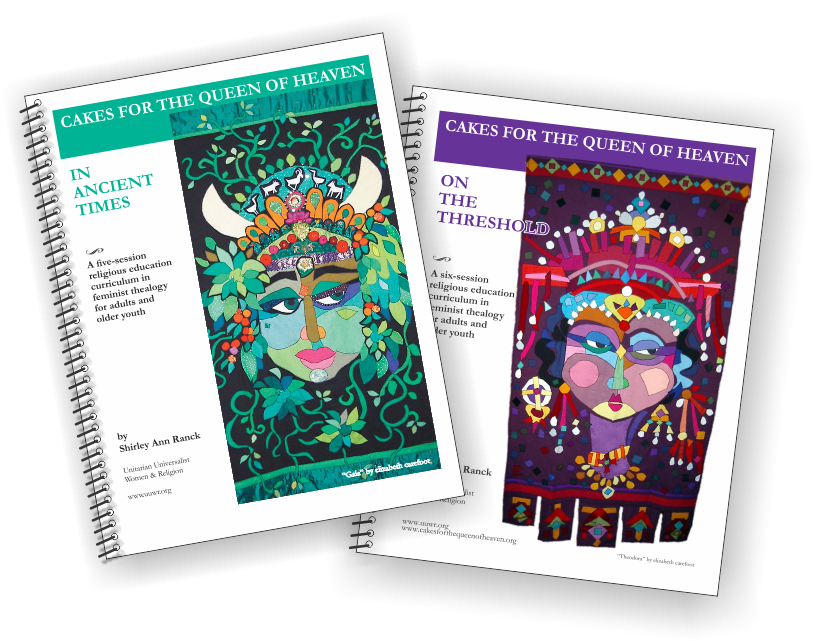Resources: Spiral Three, especially Chapter 9
Materials: Pens and journals; newsprint and marker, a goddess figure on the chalice table.
Chalice Lighting: Light the chalice and read the following quotes:
We do not want a piece of the pie.
It is still a patriarchal pie.
We want to change the recipe.
– Rosemary Matson
I am awaiting
perpetually and forever
a renaissance of wonder.
– Lawrence Ferlinghetti
Reflections: Allow up to five minutes for comments and questions that may have come up since the previous session.
Introduction: Read or put into your own words the following: The feminist imperative is the one that says that women and men are created equal in value. If wise old women were visible and powerful, perhaps we would all be well-educated about the female half of our human history. Whatever attitude or belief you may hold about God or the divine, it is a symbol that is a powerful part of our human heritage. In our dominant culture we grow up hearing this symbol spoken of only in masculine terms such as Lord and King and always referred to with masculine pronouns. In the last thirty years a growing number of women and men have been trying to change that by using inclusive language. But even today many worship services slip back into sexist language by using familiar old songs and readings in which the language has not been changed.
Many people do not notice sexist language because most of us still don’t know that for many thousands of years human beings, men as well as women, imagined the divine as female. In later times human beings imagined great pantheons of gods and goddesses. Eventually as we know from recorded history the male gods grew more and more powerful and became the chief deities in the pantheons. In our Western tradition, however, the Great Father replaced the Great Mother. Even if we are humanists we need to understand what that has done to our thinking, our language, our institutions, all of which reflect this assumption that the male is God. The mythology of a culture reflects its social arrangements. When you have a myth of God the Father and God the Son with barely a mention of any female, even the humanists in that society will carry an assumption of male supremacy. We need to keep examining our behavior and the assumptions which are still carved into our imaginations. Unexamined assumptions can affect our behavior even when our conscious intentions are good.
Journaling: Have the following questions on newsprint:
- Who are the old women in your life?
- How well do you know them?
- Are they powerful?
Allow about ten minutes for writing. Then ask for responses and put them on the newsprint and discuss them briefly.
Break
Information: Read or present in your own words the following: A picture of the earth taken from the moon may be the longed-for symbol of a world-view as new as the space age yet as old as the earth itself. If so, what religion will recognize the psychological, sociological and cosmological potential in that symbol? The picture has sometimes been centrally and prominently displayed at women’s conferences.
Among a growing number of women there may be a new religion in the making. In recent years many women have been saying that the Great Goddess is re-emerging. That statement appears to have several meanings:
- Women have discovered the Goddess within and are asserting themselves in the expression of their full human potential.
- Through the findings of modern archeology women have been researching their pre-patriarchal roots and discovering that female images of divine power pervaded the entire ancient world. This research grounds us all in a religious history which spanned thousands of years and was based upon female creativity and life stages.
- Goddess religion reminds us that we are all born of woman.
- The Goddess also reminds us that we are all born of the earth. She is a symbol of the life-supporting delicate ecological balance of the earth.
The rituals and celebrations of the Goddess religion focus on two universal themes: the life stages of woman and the beauty and wonder of the natural world. The symbols for a contemporary and future world-view may already be at hand in the re-emergence of the Goddess and in that photo of the earth taken from the moon. Is feminist spirituality articulating the religion of the future?
Journaling: Have the following questions on newsprint:
- Has feminist or Goddess spirituality been meaningful to you? In what ways?
- How do you feel about its possibilities for the future?
Allow about ten minutes for writing. Then put responses on newsprint and have the group discuss them.
Extinguishing the Chalice: Extinguish the chalice and read the following quote by Barbara G. Walker: “Thealogy is both new and old: a new view of Woman, her spirituality, and her achievements, plus a much-needed return to her roots. Underneath the surface of our patriarchal society, there are female voices calling out for this—more and more of them each year…Suppose we were free to recognize deity for what it really is, an archetypal symbol in some sense evolved by the mind of every individual born of woman: a human phenomenon only, but an important and powerful one. That would be thealogy, and it would be new. And it would lead us back to the Mother.”



